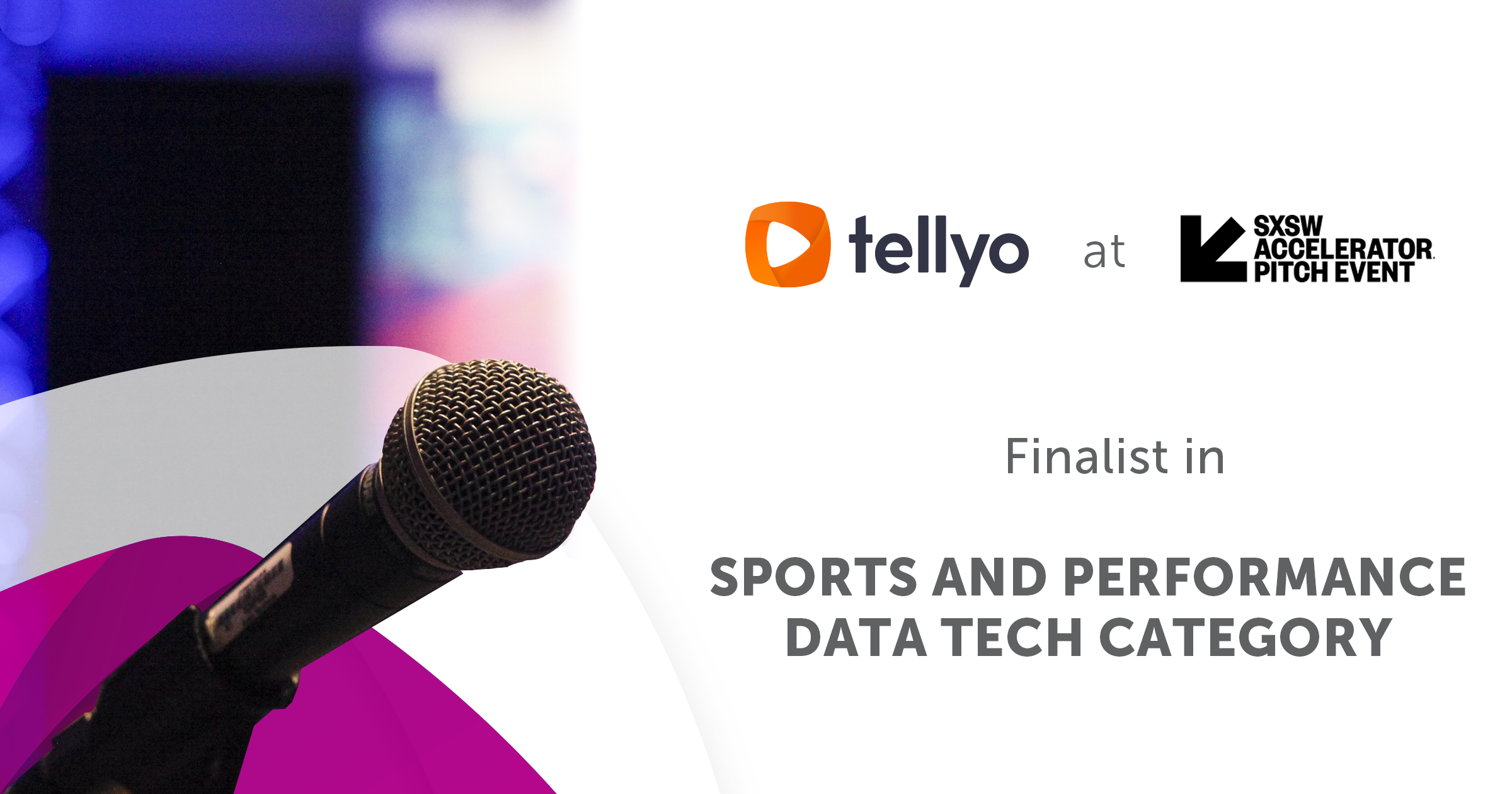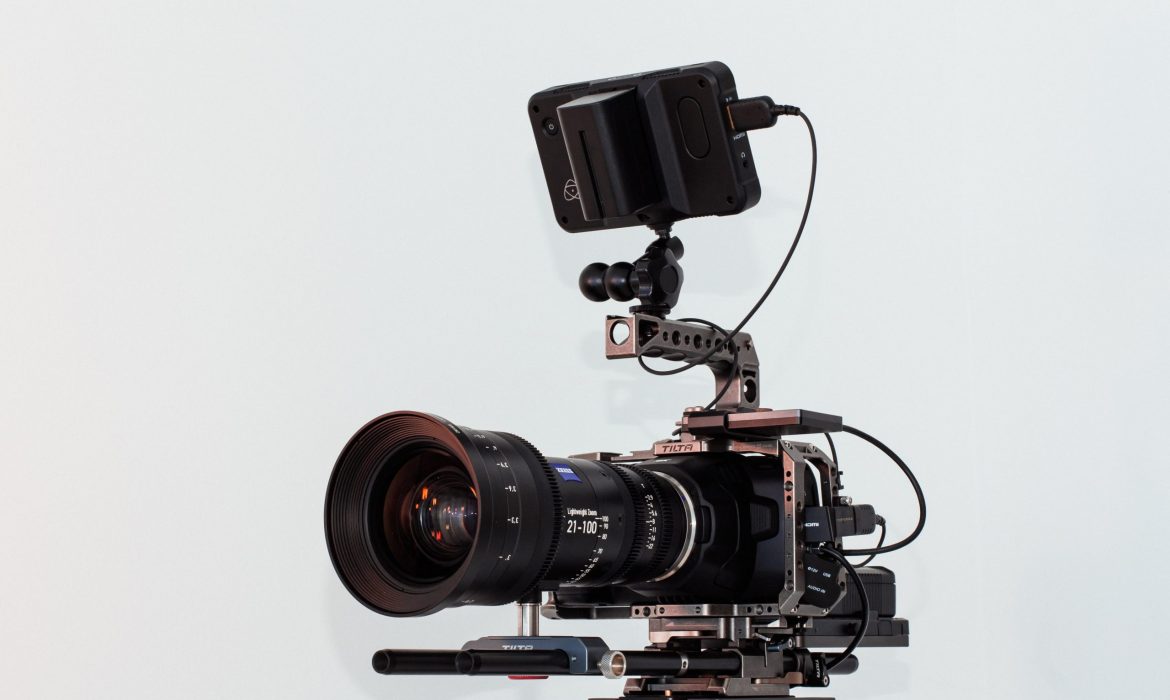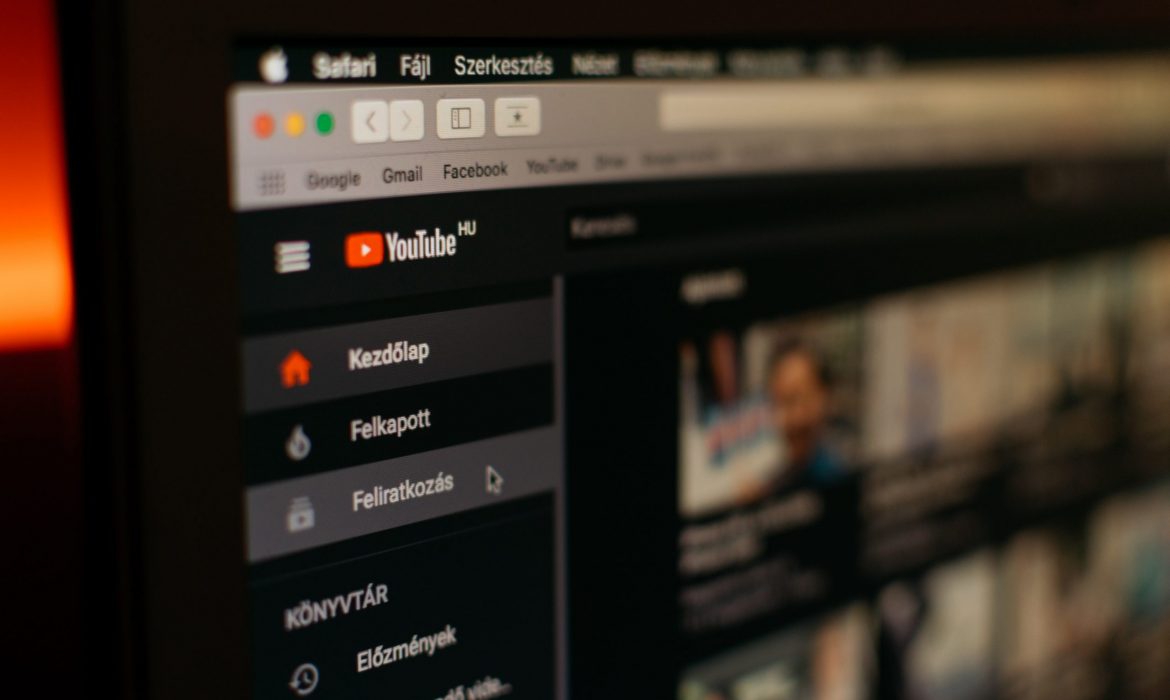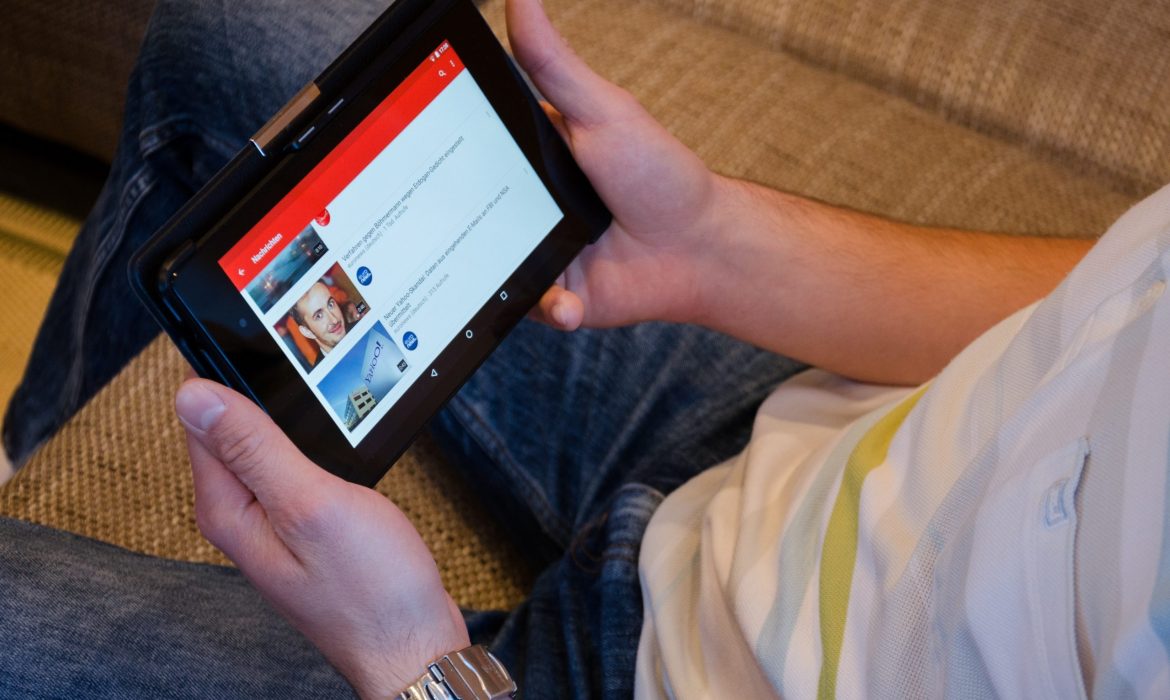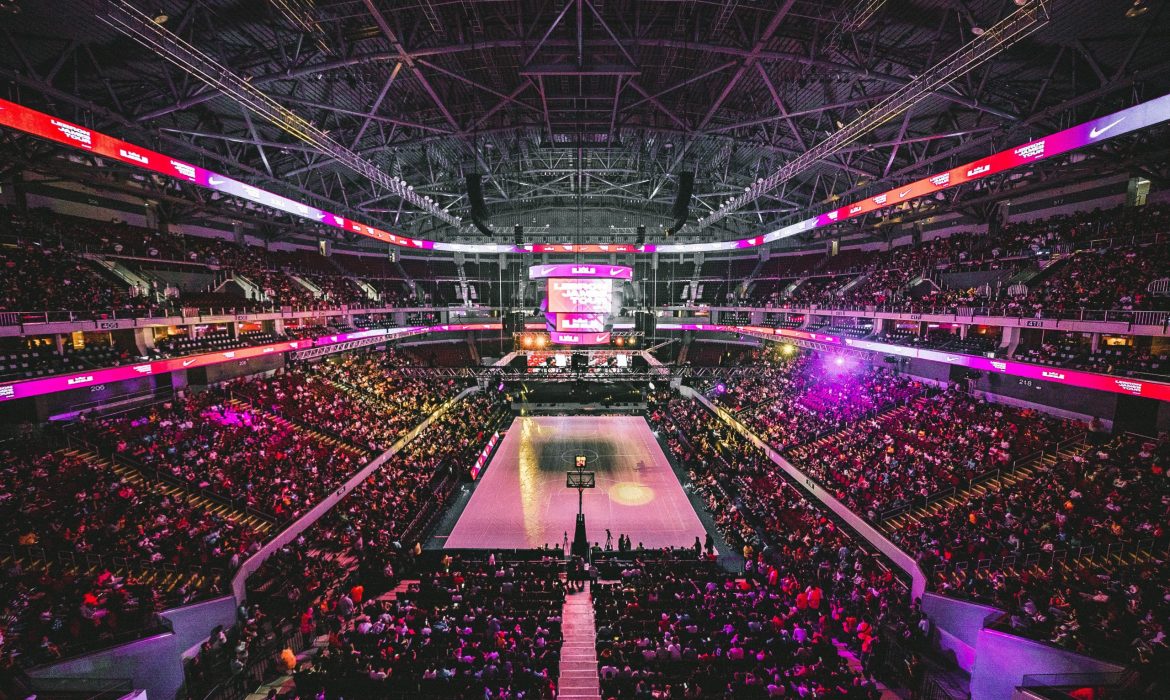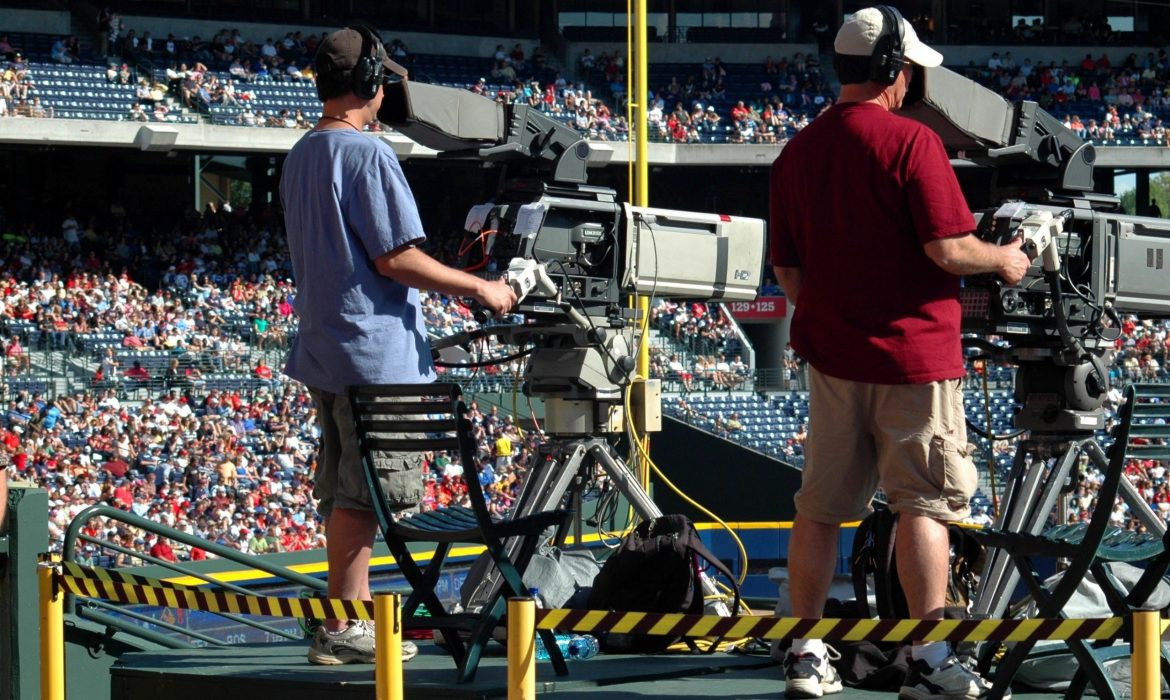Tellyo central to Ascot Racecourse fan engagement and commercial strategy
Ascot Racecourse is synonymous with global sports fans, bringing exciting horse racing meetings to thousands of spectators each year with millions more watching worldwide.
Central to their fan engagement and commercial strategy is their usage of Tellyo’s intuitive broadcast quality streaming, clipping, editing, publishing and distribution toolset.
Tellyo and Ascot Racecourse have worked together since 2017, building a trusting relationship that has enabled the Ascot Racecourse team to constantly innovate, attract commercial partnerships with their content and out perform their competitors across their digital ecosphere.
Ahead of each meeting, Rhys Hayward, the Digital Editor at Ascot Racecourse, and his team upload branded bumpers to Tellyo Pro.
With the live broadcast feed quick and easy to ingest into the system, the digital team watch the racing unfold. In real-time, the team live clip the final two furlongs of each race, where it is won and lost, and prepare the clip for distribution by adding their own graphics within Tellyo Pro.
Once the team are happy, the pre-prepared branded bumpers, showcasing Ascot’s sponsors and partners, automatically top and tail each specific piece of content to streamline their workflow.
Distributed to Twitter and Facebook within moments of the race finish, fans around the world can watch back the crucial moments and gain immediate insight.
The Ascot team successfully used Tellyo during the first part of 2021, including Royal Ascot. This helped result in a record performance for Ascot’s social channels, including 6.3m video views across the week.

After the summer break, the Autumn/Winter season officially began on Friday 1 October with a two-day Flat Meeting where the team continued their use of Tellyo.
The season continues through November with Jumps and into December with the Howden Christmas Racing Weekend.
Tellyo is at the heart of the digital teams plans and on their usage, Digital Editor, Hayward, commented, “As we continue to grow our digital audiences globally, being able to quickly share our rights across social media and beyond remains central to this.
“As we return to full crowds for 2022, Tellyo will continue to play a big role in our race day content delivery.”
Richard Collins, Chief Executive Officer at Tellyo, commented, “Ascot is a famed race track with a loyal and highly engaged global fanbase who want to engage with high quality content.
“The digital team at Ascot understand this and use Tellyo expertly to maximise their reach and engagement levels.
“The platform is designed to streamline workflows and speed up processes. The branded bumpers is just one of those areas where gains can be found and we’re delighted to see that they’ve used this to monetise their rights and enable greater awareness of their commercial partners.
“It’s going to be an exciting end of the 2021 season for the Ascot team and Tellyo will support them every step of the way.”
“Tellyo will continue to play a big role in our race day content delivery.”
Rhys Hayward, Ascot Racecourse Digital Editor
Tellyo selected finalist SXSW accelerator pitch event
We are proud to share that we were selected as a finalist in the Sports and Performance Data Technologies category for the 10th annual SXSW Accelerator Pitch Event®.
The SXSW Accelerator is the marquee event of South by Southwest® (SXSW®) Conference & Festivals (March 9-18, 2018) Startup & Tech Sectors Track, where leading startups from around the world showcase some of the most impressive technology innovations to a panel of hand-picked judges and a live audience. Out of the more than 600 companies that applied to present at SXSW Accelerator, Tellyo was selected among the 50 finalists spanning 10 separate categories.
The two-day event will be held the first weekend of SXSW Conference & Festivals, Saturday, March 10 and Sunday, March 11, on the third floor of the Downtown Hilton Austin, Salon A/B. The Pitch Event will then culminate with the SXSW Accelerator Awards Ceremony on Sunday evening, March 11, where winning startups from each category and a Best in Show winner will be announced and honored.
The Accelerator will feature finalists across the following 10 categories: Augmented & Virtual Reality, Enterprise & Smart Data, Entertainment & Content, Health & Wearables, Hyper-Connected Communities, Payment & FinTech, Security & Privacy, Social & Culture, Sports & Performance Data, and Transportation.
Tellyo will present among four other companies in the Sports and Performance Data Technologies category on Sunday 11 March 2018.
Richard Collins, Tellyo CEO, said: “We’re excited to be shortlisted for the highly prestigious SXSW Accelerator Pitch Event and honored to be sharing the stage with other leading-edge technology innovators. At the event in March, we look forward to showcasing our cloud-based video production platform, and how it helps our customers to amplify live sports events and engage with fans more effectively online.”
Tellyo’s cloud-based video production platform gives sports broadcasters and rights holders the solutions they need to easily create engaging videos from live content, and share them to social and digital channels in real-time. The company has partnerships with the International Table Tennis Federation, Guinness PRO14 Rugby, broadcaster Polsat, sports television producer Sunset+Vine, extreme sports event organiser FISE, and British Cycling.
“For the past decade, we’ve had the honor of offering a platform to some of the most cutting-edge global technologies and innovations – allowing CEOs and developers to present their solutions to investors, potential partners and key targets,” said SXSW Accelerator Event Producer Chris Valentine. “Of those who’ve presented on stage, over 70% have gone on to receive funding in excess of nearly $4.63 billion. In addition, 16% of these companies went on to be acquired. We look forward to once again being a launching pad for startups to achieve some of their greatest successes. All of us with SXSW Accelerator are proud and impressed by the companies who are truly changing industries and changing the world.”
For more information about SXSW Accelerator and to view the complete list of finalists, visit: http://www.sxsw.com/interactive/awards/accelerator.
About SXSW
SXSW dedicates itself to helping creative people achieve their goals. Founded in 1987 in Austin, Texas, SXSW is best known for its conference and festivals that celebrate the convergence of the interactive, film, and music industries. The event, an essential destination for global professionals, features sessions, showcases, screenings, exhibitions, and a variety of networking opportunities. SXSW proves that the most unexpected discoveries happen when diverse topics and people come together. SXSW 2018 will take place March 9-18, 2018.
Improve your social media stream with different content types
Remember when you had to buy an actual newspaper to see TV schedules? The good old days! Today’s world is completely the opposite, however: TV series, entertainment shows and sports events tempt you from each corner of the internet to watch them.
For broadcasters, this means you cannot simply wait for the viewer to come, because they have too much to choose from and too many other distractions. This leaves many broadcasters struggling for attention – a battle that’s impossible to win unless there is a willingness to adapt and offer more than traditional broadcasting.
Why adapt and offer something different? Let’s take a look.
The shift in attention
The data is ruthless: Gen Zers are rejecting traditional TV in favour of digital media[1]. There’s no doubt, change is in the air and there seems to be no way to reverse it.
But it’s not all doom and gloom – broadcasters just need to be prepared to try different mediums, but also to confront the demands of a different, more picky audience. The truth is that losing a viewer on the web is extremely easy, with potential viewers literally a click away from opening a new tab and moving their attention to a different place.

Broadcasters, especially those with experience in linear TV, are having to deal with this new shift, as well as learn new tools to manage the situation.
Social streaming is a great new tool in the box, but is it enough to grab attention for sustained periods of time? Especially when Gen Zers are notoriously less focused and easily distracted. The great news about Gen Zers though is that they are excellent at multitasking[3], which means they can watch a live stream, write comments and read articles at the same time!
So, if you decide to adapt to this new generation and the shift in attention, what are you going to offer? We already know that a social broadcast shouldn’t be a singular event. But what else should be part of the social broadcasting ecosystem? Next, let’s take a look at the essential ingredients.
The essential ingredients for successful social broadcasting
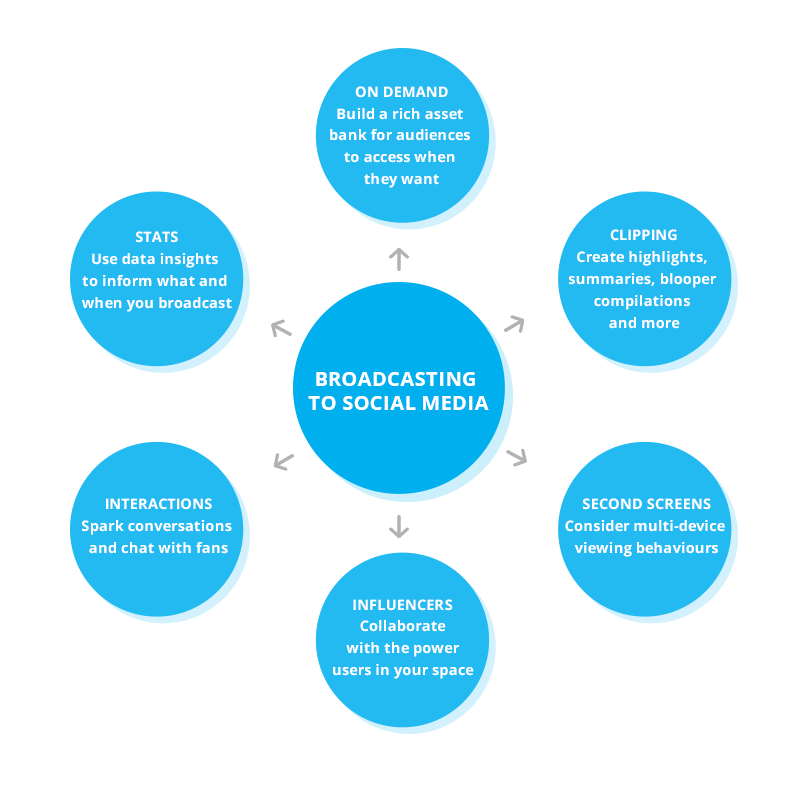
Clipping
This seems like a no-brainer, but it’s worth repeating. When streaming to a social media channel such as Facebook, keep creating and sharing bit-sized clips for those unable to watch the live stream itself. This is great for a number of reasons, as clips will help you to:
- Gain brand visibility inside and outside of your fan base.
- Increase all vital KPIs – views, reach, number of fans etc.
- Develop a rich bank of content you can upload to services like YouTube, Facebook or your own on-demand platform.
- Meet the demands of second screeners – who might be watching your live stream and catching/commenting on your clips, too.
Don’t avoid second screens – provide one!
To ‘second screen’ is to watch content on your TV and, at the same time, use a laptop or smartphone (the second screen) to check what’s going on in your social feeds, to message friends, use an app etc.
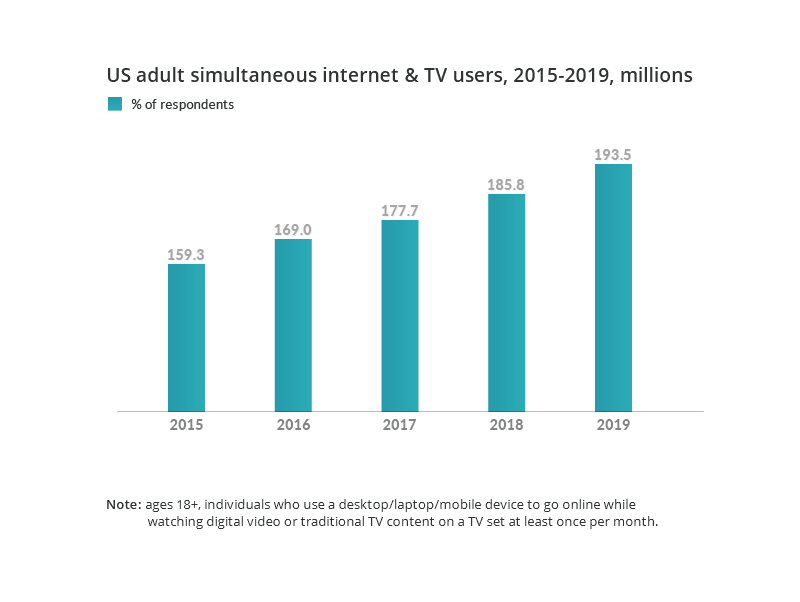
What’s in it for you? Out of 177 million second screeners in the US, 74% of viewers are interacting with unrelated content they see while watching a main event[4]. Your goal should be to make these people eager to see your content, instead of anything else.
Many second screeners are using Twitter to interact with their friends while watching a TV broadcast. They prefer to tweet, because the micro-blogging platform is quick and known for its promptness. Twitter has a 6% higher interaction rate for cross platform viewing among other social media platforms.[5]
The lesson to learn: While broadcasting, whether via a TV channel or a social stream, you should interact with your audience using other platforms. Use Twitter, Facebook or Snapchat and get involved with your audience. If you have your own mobile app, don’t hesitate to use push notifications to grab attention.
Mobile approach
Writing about the necessity of having a mobile app is soooo 2010, right? Well, it isn’t if you still don’t have one or you’re not using it properly. Mobile apps are a great marketing channel, especially if you have enough resources to keep it in good shape and your fan base is big enough to give you a good return on your investment.
How can you use a mobile app while being a broadcaster? You would use it just like any other marketing channel. But it has particular power if you treat it like an extra screen, content distribution tool and video streaming extension.
If you’re broadcasting whole TV programmes, include a calendar in the app, so your viewers can schedule reminders. If you’re streaming singular events, keep your fan base excited with news stories and premium video content available for app users only.
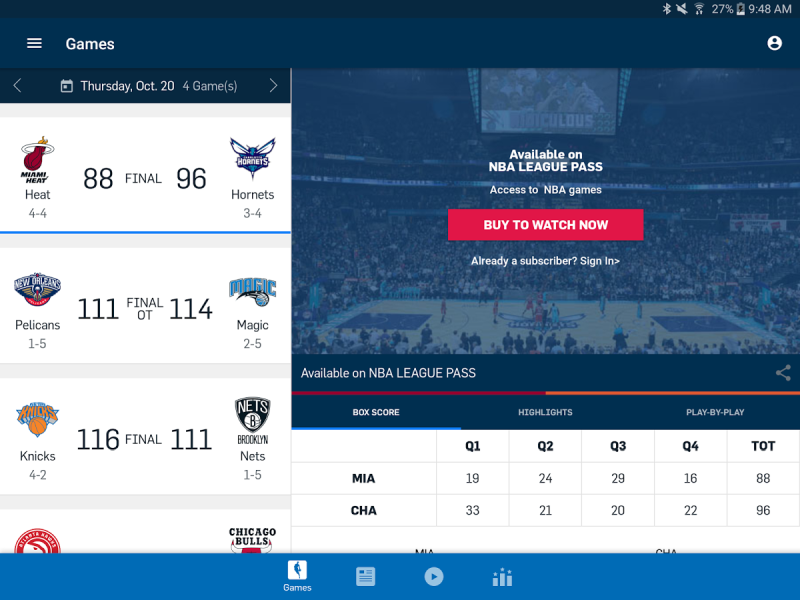
The NBA and NFL have both developed really good apps, providing live streams, video content, news and stats.
Stats and crucial details
Statistics and big data are extremely important, especially if you work in the sports broadcasting industry. Data is a gold mine for creating extra content for fans, such as stats, visualisations, comparisons, infographics etc… the list could go on.
Screen the data while broadcasting, but also create graphs, graphics and charts to publish on different social channels. Well prepared content will remain evergreen and live for a long time after its original use.
Collaborate with influencers
Collaborations with influencers in your space are a very modern solution. Essentially, by working with the movers and shakers in your environment, however big or niche they might be, will give you extra credibility and position your brand as an expert in your field.
You can collaborate with influencers in many ways: asking them for pre/post broadcast comments, involving them as expert panelists during streams, or by creating in-depth content in partnership. An influencer will provide expertise and give you a very specialised point of view.
Internet = social media
98% of people using the internet are social media users at the same time[6] – and there seems to be almost no life beyond Facebook, YouTube, Twitter or Weibo.
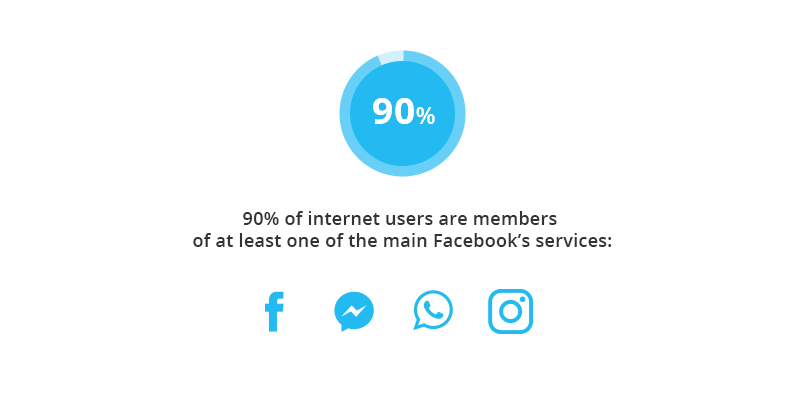
What this means is that your potential viewers are already on the web and probably on social media. As they’re already in these online spaces, you just need to reach them and spark interactions.
The good news is that potential viewers are likely to go where the good content is. So, alongside your awesome social broadcasts, share clips, create cool GIFs, publish polls, and ask your audience what they think and how they feel towards the content you’re sharing and what you’re saying – all the while encouraging conversations.
Go the extra mile!
Creating a wide range of versatile content can be time consuming and challenging. But, if done well, extremely rewarding at the same time. You might not have the budget and resources to cover all of the above solutions. But doing the social broadcast is surely the first step to take. Everything else is up to you!
[2] Nielsen Total Audience Report, Q1 2017. Daily time spent on TV, hr:min (Live+DVR/Time-Shifted): Generation Z, 2:18; Generation X, 4:38; Baby Boomers, 6:42
Brace yourself: here come the Gen Z cord cutters
The following proverb – may you live in interesting times – means a lot if you’re working in the broadcasting industry right now. In part due to new technological innovations, but also because of the generation shift currently taking place.
As Millennials get that bit older, their place as the new generation on the block is slowly being taken by Generation Z and their hard-shell habits.
The facts
Whatever you decide to call them – be it Gen Z, Generation Z, Post Millennials – they are on the rise. Here, I’m going to settle on Gen Z, the generational cohort that will hit more than 2.5 billion of the global population by 2020[1]. That’s nearly 25% of the American population. Even today, they are second biggest generation in the United States[2].
What defines the Gen Z?
Gen Z refers to people born in the late 90s – people who grew up with a mobile or smartphone in their hands, literally.
Learn more: A simple guide to targeting generation Z with videos
Gen Z spends at least one hour a day online, with almost half of them being connected for more than 10 hours every day! To make this even more complicated, they’re using many different devices, sometimes simultaneously. For many people who remember their parents telling them not to stare at the TV for too long, the stats will highlight just how different Gen Z really are.
Cord cutting
A characteristic that truly defines Gen Z is cord cutting. This generation get their content kicks from wi-fi enabled, standalone devices – often the smartphone – with the most popular platforms being YouTube, Snapchat, Instagram and Facebook. It’s no coincidence that these popular platforms are also the most popular ones for watching videos. That’s because [bctt tweet=”Gen Z loves video!” username=”TellyoTV”]But, unlike Millennials and Generation X, they consume it mostly via the web, their native environment.
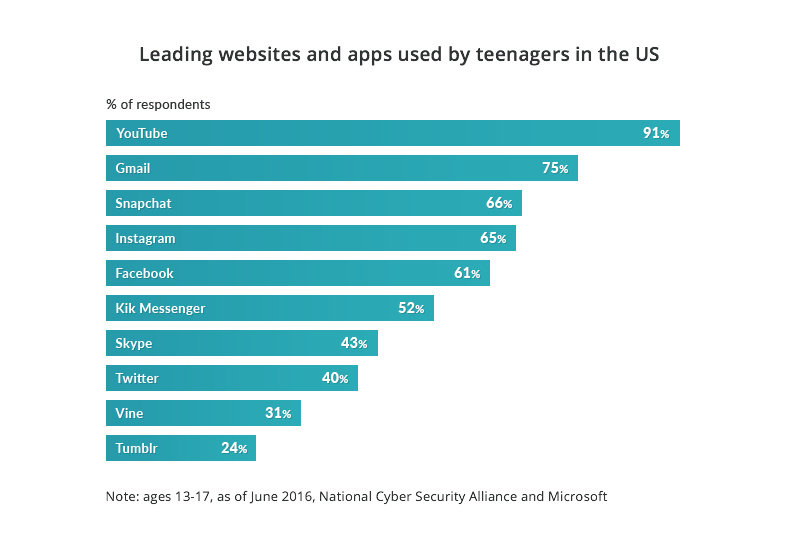
It’s not that Gen Z aren’t watching TV at all. They do, primarily because many are still living at home where their parents watch television and the TV in the living room is often a standard satellite or a cable one. A family home is also more likely to have a combined cable/internet package deal, so families are not forced to choose between just the internet or the hundreds of traditional TV channels.
Even so, Gen Z do consume entertainment in a slightly different way. Gen Z teens spend more time watching Netflix and YouTube (combined 59%) than watch traditional TV (29%)[3]. And, as Gen Z grows in size, cable TVs look to be in slow decline with the process seemingly unstoppable.
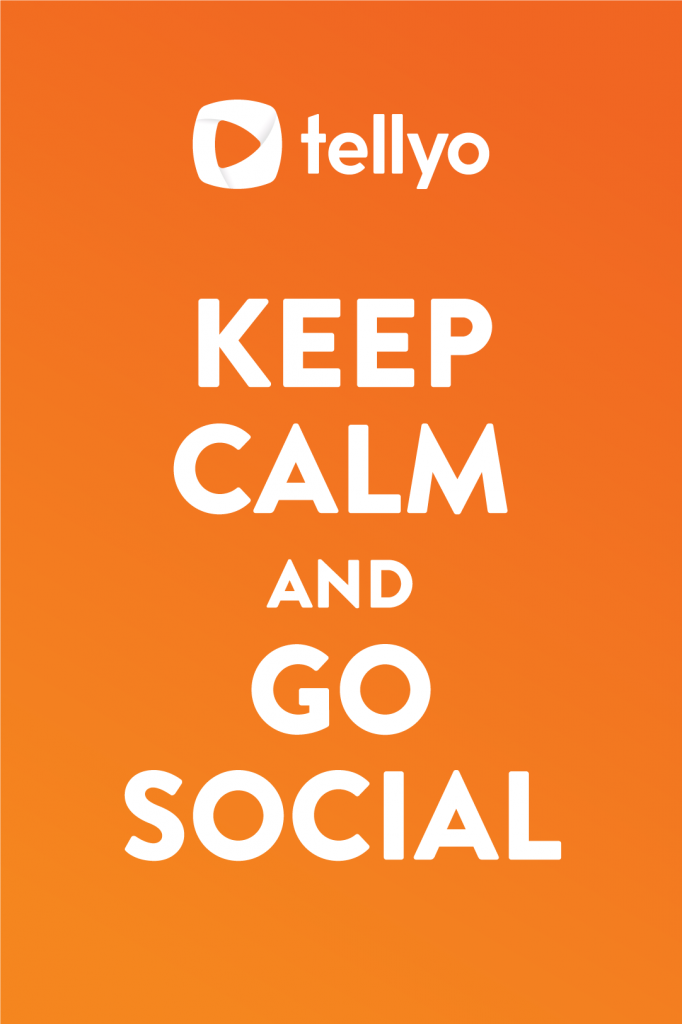
For now, most Gen Z teens are still living with parents. But soon they will start their own families and buy their first homes. At which point – Will they buy TV sets? Are they going to sign up for cable TV? Or will their behaviour be further shaped by watching music videos on YouTube, chilling with Netflix and checking the weather on a smartwatch’s screen? There are no easy answers.
Winds of change…
Just to be clear – cord cutting is not a myth, nor is it a monster that eats traditional televisions for breakfast!
It is a generational shift, influenced by many things such as technological advances, the prevalence of social media and changes in behaviour. However, it does seem that the process of cord cutting is irreversible. Something that broadcasters needn’t be afraid of, as many opportunities await.
[1]Gen Z Report 2016 by Fung Global Retail Tech August 29
[2]http://www.goldmansachs.com/our-thinking/pages/macroeconomic-insights-folder/what-if-i-told-you/report.pdf
[3]http://trifectaresearch.com/wp-content/uploads/2015/09/Generation-Z-Sample-Trifecta-Research-Deliverable.pdf
What indicates success? The social video KPIs that count
Ok, so you’ve broadcasted another video to Facebook… Surely you gained some likes, comments and shares. But is that all you should expect? What really indicates success?
To help you measure outcomes, here are the indicators you should take into account. Let’s take a closer look.
Views
These are a very informative but basic indicator. Views are the most popular way to measure the success of video content and every social platform will provide this information. But views don’t tell the whole story. They’re more like the first chapter – a small glimpse at how your video is performing. So, [bctt tweet=”when choosing KPIs for your video strategy, don’t just stop at views.” username=”TellyoTV”]
Subscribers or Followers
The name of this indicator can vary from platform to platform. However, it’s one of the most vital ratios, with the number of people following your social channels hugely impacting other KPIs. When creating a video or broadcasting strategy, you should include fan, follower or subscriber growth, and ratios to other KPIs such as views.
Learn how to incorporate sponsorship into your real-time social videos
To increase subscribers, for example, remember to use call to actions (‘Subscribe to our channel!’), or subscribe buttons within a video and a link within its description.
Drop off rate
This indicates how many people watched your video and dropped off after 5, 10 or 30 seconds. It’s absolutely natural for this KPI to drop initially during some of your first attempts at video, but there are many practical things you can do to decrease drop off rates.
To do so, you might shorten video intros and cut the length in general to condense your message.
Watch your video one more time before publishing. Ask yourself: Does it need shortening? Does it get to the point quickly enough? Where’s the beef?
Conversion rate
This indicates how efficient your content is, but it’s rarely linked with video marketing or broadcasting in general. Whether you decide to include in your KPIs will depend on your goals. For example, if you wish to increase the number of subscriptions to your video service, and video is your main content, you may want to include this KPI in your quarterly or yearly marketing strategy.
You can convert viewers into subscribers, or even new customers, in many ways:
- Include call to action buttons in your videos. Play with the copy and design to test what works best for you.
- Remember to add call to actions and links with your video descriptions too.
- Use specially created email addresses and phone numbers to measure the direct impact of your videos on business enquiries.
It’s up to you!
No matter what set of KPIs you decide to measure, always give yourself time.
Collect the data over a reasonable period, which will enable you to see the whole picture and insightful patterns.
If you’re already using Tellyo – check out our Analytics section to see insights related to your content. Using our platform you also have access to other features, all of which are designed to make your content better and more attractive to viewers… so helping to boost your KPIs.
A recipe for video content success: Lonzo Ball and the Summer League buzz
While it’s not everyone’s favourite, partly due to being played in the silly season, this year’s NBA Summer League was truly special. Lonzo Ball was the star earning MVP status on the court, while his father courted controversy off it. The surrounding buzz led to record viewing figures – with six of ESPN’s seven most-viewed games featuring the LA Lakers draft star.
ESPN proved willing to run with the Lonzo hype and the buzz his father, LaVar, was able to build around him. The channel struck gold with the duo, and their presence helped to build a buzz around the Summer League.
Some of the factors that helped build a buzz:
- A superstar in the making
There’s no doubt, Lonzo is a superstar on the rise. He has outstanding skill and is an unusual size for his position, which makes him an interesting proposition. It didn’t hurt that he brought passion and emotion to the court in front of big crowds in the stands and on TV, making him the Summer League’s Most Valuable Player.
- Lonzo, the lead story
Matching his performances, Lonzo maintained a position as the most written-about player throughout the Summer League. Media Cloud stats tell the story – he outpaced other players with 702 mainstream news stories, more than the 2nd and 3rd players combined.
- LaVar, a slice of controversy
There’s no doubt that “a ton of the attention Lonzo receives stems from his brash, outspoken father, LaVar,” according to a fantastic article on the FiveThirtyEight website. As he tried to bolster his family’s brand value any way he could, one of LaVar’s standout comments was to claim he was a better basketball player than Michael Jordan. Tweeters used #lavarballsays to mock him (ironically adding more fuel to the selfless promotion of the Ball name).
- The media were kept guessing
With Lonzo yet to sign a shoe deal with one of the major brands, masses of media attention surrounded what sneakers he would wear. This speculation was only encouraged by the Ball family releasing their Big Baller Brand shoes. So every time Lonzo put on a different pair of sneakers, people would be asking is it another marketing ploy?
What was the recipe for ESPN’s success?
ESPN fully capitalised on the buzz surrounding the Summer League. By combining TV broadcasts with video content and social media activity, the channel was able to engage its audience and even make some good gains. For example, 2017 Google Trends data shows huge increases in searches related to ‘NBA Summer League’.
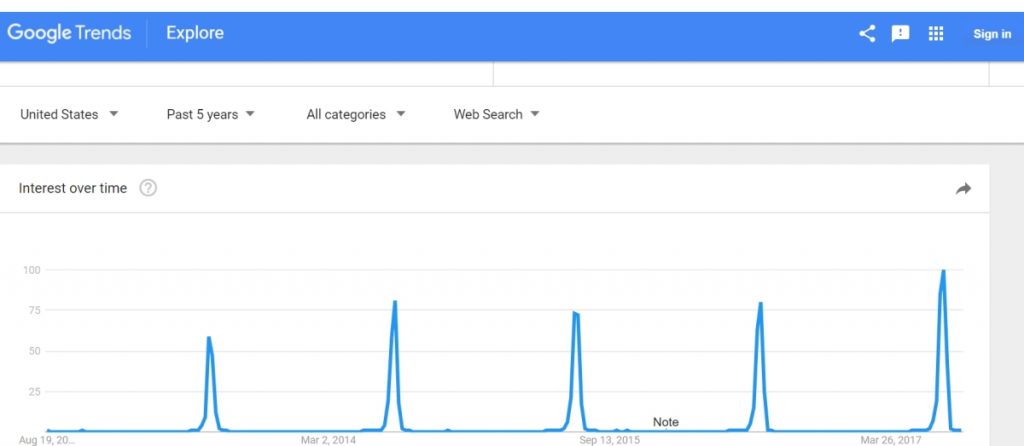
Google Trends for “NBA Summer League” term popularity
ESPN seemed to get its mix of ingredients just right.
- Great timing
The silly season is usually a bad time to break records. But the game between two great teams (Boston Celtics vs LA Lakers) and the duel between draft picks 2 and 3 (Lonzo Ball of the Lakers vs Jason Tatum of Celtics) presented opportunities for ESPN.
To hype the game, ESPN broadcasted a three-part documentary – Best of Enemies – exploring the Celtics/Lakers rivalry as part of its 30 for 30 series. The game itself was the most-watched Summer League game ever, with over 1.1million views on ESPN.
- Tons of shareable content dedicated to Lonzo Ball
Through content, ESPN were able to build a narrative thread that resonated with fans. It managed to maintain the hype surrounding the lead star, presenting Lonzo Ball as the future superstar and maybe as good as his father claims he is!
More than 1,000 articles and videos dedicated completely or partially to Lonzo or other Ball family members have also been created by ESPN.
- Big characters can add to the story
Lonzo Balls’ father, LaVar, was definitely one of the stars of the Summer League. You can dislike him, but the hype around his son is definitely his success. His opinions also get him airtime. On ESPN’s First Take Show, LaVar gets into a heated debate regarding his views on beating Michael Jordan in a game of one-on-one!
You may not have a Lonzo in your locker, or even want a LaVar on your team! But I hope you can take away some of the ingredients that created such a buzz around the Summer League and made it such a success.
Get inspired: compelling examples of sports brands using video content
When it comes to online video, audiences have developed a highly sophisticated filter. They can easily differentiate sterile marketing products from content made with real passion.
Cutting through this filter can be a challenge. How can you ensure your well-produced, professional and inspiring stories stand out? How do you make them sincere and genuine for your audiences?
There are lessons to be learned from other sports brands. Here are some examples of videos made with true passion and dedication.
Urbex by Red Bull
Red Bull is all about giving you energy to increase performance. With its Urbex videos the brand lives its promise, showcasing urban explorers performing at the edge, sometimes literally! These explorers risk life and limb doing stunts on the most extreme of man-made structures. Strictly off-limits, these forbidden structures might be a massive skyscraper in Dubai, a cosmodrome in Kazakhstan or abandoned tunnels below a big city.
While Red Bull’s content is always avant-garde, the Urbex series is some of the most epic video content ever produced. Each 40-minute episode focuses on two or three urban explorers as they scout their structures, and plan and perform mind-blowing stunts. If you suffer from a fear of heights, you might want to stay away. If not – prepare to collect your jaw from the floor!
Lesson to take away: remember the DNA of your brand, live its promise and keep it real!
ParaTough by the Canadian Paralympic Committee
Paralympic sports have until recently existed on the periphery. That’s until organisations like the Canadian Paralympic Committee (CPC) started tearing down some barriers and redrawing the boundaries.
With its ParaTough videos, the CPC challenged people to re-evaluate how they view people with disabilities taking part in sport. The videos were even able to go further, showing that not only are paralympic sports people working harder but their struggle is actually more heroic. Videos in the campaign show examples of the exercises that helped these heroes reach the Paralympic Games. Will you dare to try at least one of them?
Lesson to take away: engage users by showing them real struggle – the pain, the sweat, the sacrifice. Dare them to take part and better themselves in some way.
This Girl Can by Sport England
Sport England is a UK public body responsible for growing the number of people taking part in sports. It identified a need to empower more women to take up sporting activity and to counteract anxieties and assumptions that might make women feel they can’t get involved.
With its This Girl Can campaign, Sport England empowered women of all ages and ethnicities to do sports and take up general physical activity. Campaign video spots showed everyday women having fun in the gym, at running tracks, on football pitches, in boxing halls, or simply in their backyard! In the videos, the women all look natural, strong and inspiring, which has given the campaign immense credibility and made it a huge success.
Lesson to take away: empower your audience by showing that they can do cool and inspirational stuff.
‘Beauty and the Bull’ by Chicago Bulls
Just like combining apples and oranges – they’re pretty cool separately, but nobody thinks about mixing them together – so it was with the Chicago Bulls and musicals. There are Bulls’ fans and musical fans, but fans of these two things? Not so likely.
But when the six-time NBA title winners prepared a musical for their fans, it was a huge gesture and extremely well received. Produced using smartphones and Snapchat, ‘Beauty and the Bull’ was a three-minute story told through short-form videos – each clip lasting only a couple of seconds. It wasn’t the best, most cutting-edge production of all time, but fans were positive in their feedback. While we don’t expect to see Real Madrid making their own Snapchat version of Don Quixote, the idea was cool and executed nicely in an authentic way. You may not like it, but you can’t deny it’s a fresh and innovative idea to use.
Lesson to take away: sometimes it’s good to create something completely new, just from the bottom of your heart. Fans will appreciate it!





